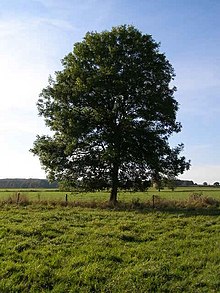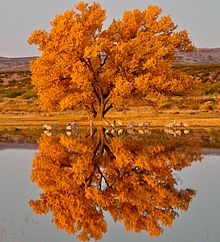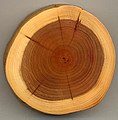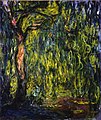The Trees Portal

In botany, a tree is a perennial plant with an elongated stem, or trunk, usually supporting branches and leaves. In some usages, the definition of a tree may be narrower, including only woody plants with secondary growth, plants that are usable as lumber or plants above a specified height. In wider definitions, the taller palms, tree ferns, bananas, and bamboos are also trees.
Trees are not a monophyletic taxonomic group but consist of a wide variety of plant species that have independently evolved a trunk and branches as a way to tower above other plants to compete for sunlight. The majority of tree species are angiosperms or hardwoods; of the rest, many are gymnosperms or softwoods. Trees tend to be long-lived, some reaching several thousand years old. Trees evolved around 370 million years ago, and it is estimated that there are around three trillion mature trees in the world currently.
A tree typically has many secondary branches supported clear of the ground by the trunk, which typically contains woody tissue for strength, and vascular tissue to carry materials from one part of the tree to another. For most trees the trunk is surrounded by a layer of bark which serves as a protective barrier. Below the ground, the roots branch and spread out widely; they serve to anchor the tree and extract moisture and nutrients from the soil. Above ground, the branches divide into smaller branches and shoots. The shoots typically bear leaves, which capture light energy and convert it into sugars by photosynthesis, providing the food for the tree's growth and development.
Trees usually reproduce using seeds. Flowers and fruit may be present, but some trees, such as conifers, instead have pollen cones and seed cones. Palms, bananas, and bamboos also produce seeds, but tree ferns produce spores instead.
Trees play a significant role in reducing erosion and moderating the climate. They remove carbon dioxide from the atmosphere and store large quantities of carbon in their tissues. Trees and forests provide a habitat for many species of animals and plants. Tropical rainforests are among the most biodiverse habitats in the world. Trees provide shade and shelter, timber for construction, fuel for cooking and heating, and fruit for food as well as having many other uses. In much of the world, forests are shrinking as trees are cleared to increase the amount of land available for agriculture. Because of their longevity and usefulness, trees have always been revered, with sacred groves in various cultures, and they play a role in many of the world's mythologies. (Full article...)
The Mingo Oak (also known as the Mingo White Oak) was a white oak (Quercus alba) in the U.S. state of West Virginia. First recognized for its age and size in 1931, the Mingo Oak was the oldest and largest living white oak tree in the world until its death in 1938.
The Mingo Oak stood in Mingo County, West Virginia, in a cove at the base of Trace Mountain near the headwaters of the Trace Fork of Pigeon Creek, a tributary stream of Tug Fork. The tree reached a height of over 200 feet (61 m), and its trunk was 145 feet (44 m) in height. Its crown measured 130 feet (40 m) in diameter and 60 feet (18 m) in height. The tree's trunk measured 9 feet 10 inches (3.00 m) in diameter and the circumference of its base measured 30 feet 9 inches (9.37 m). Assessments of its potential board lumber ranged from 15,000 feet (4,600 m) to 40,000 feet (12,000 m). Following the tree's felling in 1938, it was estimated to weigh approximately 5,400 long tons (5,500 t). (Full article...)Did you know? -
- ... that President Bill Clinton said he would personally pay the bill to keep the National Christmas Tree (pictured) lit during the government shutdown resulting from disagreements on the 1996 federal budget?
- ... that global precedence is the tendency to see the forest, and not the trees?
- ... that the mistletoe species Amyema congener of eastern Australia can grow on non-native peach, plum and pear trees?
- ... that foliage from the Australian rainforest tree Grevillea baileyana was used in the floral arrangements handed to medal winners at the 2000 Summer Olympics in Sydney?
- ... that most of the habitat of the vulnerable tree Eucalyptus benthamii has disappeared under Warragamba Dam or been cleared?
- ... that the inspiration for the Paustian House in Copenhagen came to architect Jørn Utzon while he was walking through a forest of beech trees?
- ... that Washington was the second largest tree of its kind until its collapse in 2005?
Selected article -
Populus section Aigeiros is a section of three species in the genus Populus, the poplars. Like some other species in the genus Populus, they are commonly known as cottonwoods. The species are native to North America, Europe, and western Asia. In the past, as many as six species were recognized, but recent trends have been to accept just three species, treating the others as subspecies of P. deltoides.
They are large, deciduous trees that are 15–30 m (50–100 ft) tall and diameters of 4 m (13 ft), distinguished by thick, deeply fissured bark and triangular-based to diamond-shaped leaves that are green on both sides (without the whitish wax on the undersides) and without any obvious balsam scent in spring. An important feature of the leaves is the petiole, which is flattened sideways so that the leaves have a particular type of movement in the wind. (Full article...)General images
Selected lists
Subcategories
Related portals
Associated Wikimedia
The following Wikimedia Foundation sister projects provide more on this subject:
-
 Commons
Commons
Free media repository -
 Wikibooks
Wikibooks
Free textbooks and manuals -
 Wikidata
Wikidata
Free knowledge base -
 Wikinews
Wikinews
Free-content news -
 Wikiquote
Wikiquote
Collection of quotations -
 Wikisource
Wikisource
Free-content library -
 Wikispecies
Wikispecies
Directory of species -
 Wikiversity
Wikiversity
Free learning tools -
 Wiktionary
Wiktionary
Dictionary and thesaurus
-

-

-

-

-
Random portal

Purge server cache



































































Recent Comments